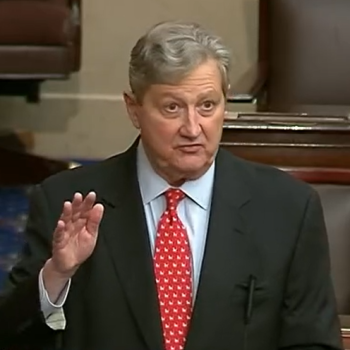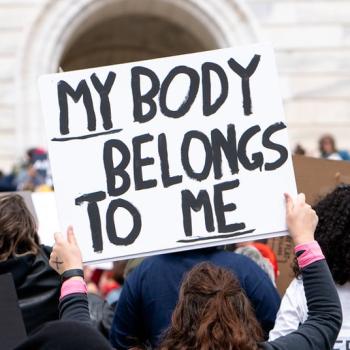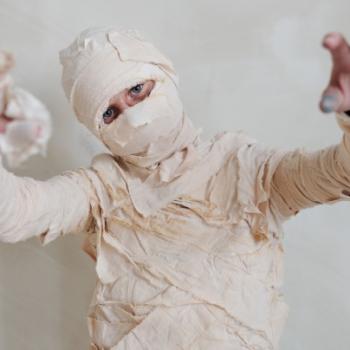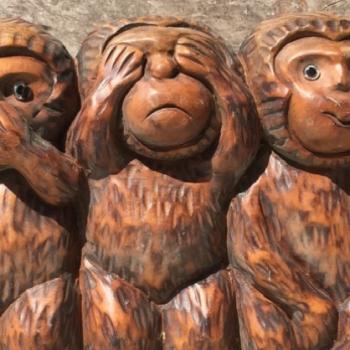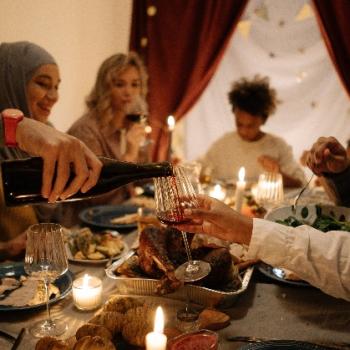Painting “The First Thanksgiving” by Ferris is racist propaganda misrepresenting the first meal between White settlers and Native Americans.
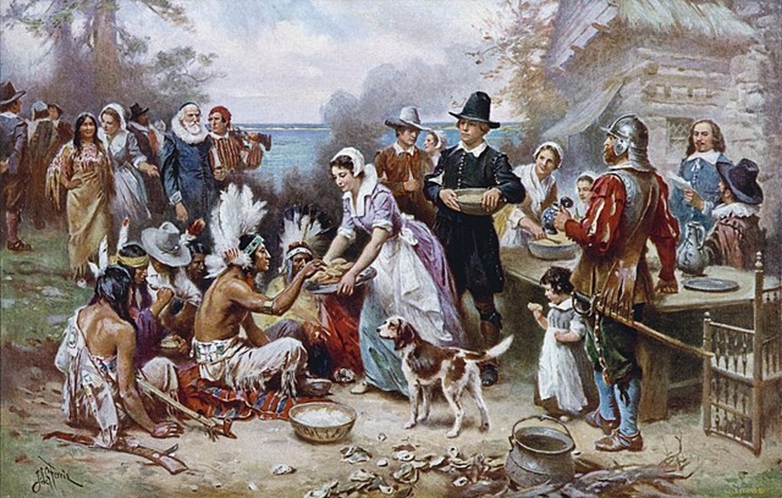
As we gather around Thanksgiving tables or watch children’s school assemblies, we hear stories of peaceful and harmonious interactions between Native Americans and White settlers. The painting, “The First Thanksgiving,” by Jean Leon Gerome Ferris depicts the first mythical meal shared by the two groups. In his blog, Teddy Barbier writes about the famous piece of art that functions more like racist propaganda to give the stamp of historical approval to White conquest.
The Real Story
Barbier explains that the Ferris painting inaccurately depicts a peaceful relationship between the two groups:
According to the legend, when the first British settlers (mostly Puritans) arrived in North America (Plymouth colony) half of them died of starvation. So, Native Americans taught them how to grow vegetables and other plants that were unknown to Europeans. The Wampanoag helped the Pilgrims obtain food. They taught them to grow crops and showed them the best places to fish. A year later, it is thought that the settlers shared their first harvest with the Native Americans to show them their gratitude…
Contrary to the Thanksgiving myth, the Pilgrim-Wampanoag encounter was no first-contact meeting. Rather, it followed a string of bloody episodes since 1524 in which European explorers seized Wampanoags to be sold into overseas slavery or to be trained as interpreters and guides.
We Must Unlearn
Growing up in Virginia, I learned early on that the first Thanksgiving was not in Plymouth, but on the banks of the James River. Still, that doesn’t improve the situation. Both colonies treated Native Americans horribly. White settlers killed, raped, and enslaved countless people who were the first inhabitants of North America. I encourage you to read the New York Times article, “Everything You Learned About Thanksgiving is Wrong.” This article challenges many of the misconceptions we got from our childhood classrooms. We must unlearn the stereotypes and myths that surround this American holiday.
A Closer Look at the Painting
They say, “A picture is worth a thousand words.” By taking a closer look at Ferris’s painting, we can see the thousand harmful words embedded in a single image. Of course, I never knew Ferris, and don’t presume to know his innermost thoughts. Charitably, I’ll say that he probably did the best he could with the knowledge he had at the time. Yet, the imagery conveys ideas of culturally ingrained White supremacy that must be decoded if we are going to learn to do better.
Native Americans Depicted
First, let’s look at the depiction of Native Americans. Teddy Barbier makes two observations that bear repeating. First, whether we are talking about the Powhatan tribe in Virginia or the Wampanoag tribe in Massachusetts, it is equally true that neither group wore a full headdress of feathers, as depicted in Ferris’s image. Second, and more importantly, Barbier points out the positioning of the Native Americans relative to the White settlers:
Indeed, The Indians are sitting down – kneeling down as to beg for food – whereas the settlers are standing up. The Indians are placed on the same footing as the dog – a spaniel [it is known that one arrived on the Mayflower]-and the children. The picture’s message is quite clear: New World men are equal in development to Old World children and animals. The Amerindians are infantilised. It is as if they could not take care of themselves and had to rely on the European settlers.
Observe the Native gentleman seated on the far left. On his lap, he holds a peace pipe visible to his White hosts. Yet, just behind his right hand, a war club lies within reach. This speaks to the mistrust between Native Americans and settlers. He is right in mistrusting colonizers, as his people had already been mistreated before this encounter. So, while he overtly makes peaceful overtures, he keeps a means of self-defense close by.
Now, examine the two men seated between the gentleman with the peace pipe and the one with the feathered headdress. The one with the yellow headband is tasting something from a pot, using a spoon. The other wears a European-styled hat with a feather stuck in its band. Both demonstrate the White painter’s understanding of Indigenous people adopting Anglo ways. In this fictionalized depiction, the original inhabitants have already accepted White customs.
White Men Depicted
Next, I want you to notice the man who stands guard over the child in front of the table. A tankard is in his left hand, leaving his right hand free to draw sword in need. He wears a bright helmet and hard leather jerkin to protect him in case the Thanksgiving meal turns sour. His armor suggests that he represents the colonial military.
Standing above the fellow in the feathered headdress is another White man with a musket over his shoulder. He seems to be a civilian settler. He cautiously looks toward his wife, who is engaged in conversation with a Native woman. Both men stand ready, in case their Native guests choose the war club over the peace pipe. In the center, an unarmed man stands ready to serve, yet appears cautious as his wife serves their new neighbors.
On the left, take note of the clergyman in black robe, white ruffled collar, and black skull cap. He represents religion, which was one way that White settlers tried to control their Native neighbors. He holds a Bible tucked under his left arm, like the sword at the soldier’s belt. These two men—the clergyman and the swordsman—keep direct eye contact.
On the right, observe the gentleman with Puritan collar and hat, with papers in his hand. Perhaps this is an early map, as White men immediately wanted to explore. Or it could be a treaty—the kind that the settlers were never good at keeping. In either case, maps and broken treaties were another way that colonialists trespassed on the territory of Native Americans. This man with the papers seems to be in charge and also looks to the swordsman to keep things under control.
Peaceful Women and a Curious Dog
If there is any hope to be found in this painting, it is in the peaceful women on both sides. Whether serving or being served, the women in Ferris’s painting stand with postures of interest and engagement. On the left, a White woman whispers something intimately in a Native woman’s ear. The woman serving the turkey wears a genuine smile on her face. The woman with the mixing bowl likewise bears an inquisitive expression. The spaniel takes its cue from the women rather than the men, as it looks towards the guests with curiosity and a wagging tail.
A Closer Look at Ferris’s “The First Thanksgiving”
Ferris’s beloved painting “The First Thanksgiving” displays racist propaganda. It portrays a guarded paternalism on the part of the White settlers. It also depicts infantilized Native Americans eating from the hands of their White proprietors. These ideas lay the groundwork for White supremacy, colonialism, and manifest destiny.
Yet, embedded in this painting that conveys such horrible concepts, we can also find hope. It’s possible to overcome the caution and suspicion with which one people group looks upon another. We can do this by following the examples of the women and even the dog in Ferris’s painting. While some may disguise their covert violence with overtures of peace, we can lean into one another with genuine interest and curiosity. Instead of seeking to control others with religion or government, we can serve each other with a smile and learn from our neighbors with a spirit of openness.
If you happen to see “The First Thanksgiving” by Ferris this holiday season, I hope you’ll take a closer look. Take the opportunity to acknowledge how we too often learn history through propagandistic images. Recognize the racism inherent in many of our “historical” traditions. Then, once you’ve learned better, seek out how you can do better. We don’t have to be bound by the stereotypes and mistakes of our past.
Native American Heritage Month
November is Native American Heritage Month. This month, I hope you’ll use the occasion to learn about the history of the original inhabitants of North America. I recommend the book, 1491: New Revelations of the Americas Before Columbus, by Charles C. Mann. It’s a good first step toward understanding the unique people who first settled in the Americas.






